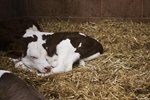
A calf experiences her mom’s tough love within moments of arrival. The mother cow cleans away placental membranes, stimulates blood flow and dries her baby off with aggressive swipes of her rough tongue. Mom’s attention also establishes a close bond with her calf that lasts until weaning. The time for weaning and independence for your calf depends on whether she was born on a dairy, beef or hobby farm.
Life as a Newborn
Although it’s hard to picture those spindly legs and knobby knees holding anything up, a healthy newborn calf rises and wobbles towards mom within moments of birth. It may take a few tries, but once your calf can stand without falling, she’ll give mom’s udder a healthy bump with that wet nose and enjoy her first meal. For three days, mom’s milk will consist of antibody-rich colostrum, a formula that gives your calf a healthy start on life. Her four-part stomach or rumen will function fully at six to nine weeks, which she needs to absorb nutrients from solid food.
When Milk Is in Your Genes
Dairy calves begin life the same as any other, but farmers have a different plan for the milk mom produces. Once colostrum production ceases, farmers typically choose to transfer dairy calves to a bottle. If intended to join the herd, the calf is separated from mom and fed from a bottle with milk replacer, supplemented with small amounts of a nutrient-rich, solid food called calf starter at about four days of life. As the calf’s rumen develops, the milk is gradually decreased and the calf starter increased. Most dairy farmers wean the milk completely by eight weeks. The Louisiana State University College of Agriculture notes though that successful weaning from milk to calf starter can occur at four to five weeks without negatively affecting the health of calves.
Running the Ranch
Beef cattle typically give birth outdoors in a pasture. Aware of pending calving time, ranchers keep close watch over the herd to identify cows having difficulty, but the process generally proceeds as nature intended. Calves stay with mom until weaning day, from three to eight months. The longer a calf can stay with mom the better, but earlier weaning occurs when the cow is in ill health or the rancher needs to cull the herd for one reason or another. Calves are physically separated from mom, and both spend a few days searching for one another. It’s a difficult time, and Oregon State University Extension recommends vaccinating calves three to four weeks before weaning to help decrease weaning stress to the immune system.
Small Farm Living
If you’re starting a hobby farm, you can begin your cow herd by purchasing a bucket calf, one who has been separated from mom but still needs bottle feeding. A calf “bottle” often consists of a specialized nipple attached to a bucket, hence the name. Most often sold by dairy farmers, bucket calves should have colostrum for at least three days before you bring them home. For the healthiest start, look for calves whose eyes are bright and free of discharge. They should suck eagerly from your fingers, and bottoms should be free of wetness or diarrhea. Contact a local vet before choosing your calf to ensure you’ll have medical advice should your calf refuse to eat or become ill.
References
Photo Credits
-
Jupiterimages/BananaStock/Getty Images
Writer Bio
A medical writer since 1990 and successful home-based business owner for more than 14 years, Sandra King holds a Bachelor of Arts in communications. She uses her formal education, professional insight and extensive volunteer involvement to cover topics on health and fitness, pets, parenting for a lifetime, building healthy relationships, conquering business basics and developing career goals.



